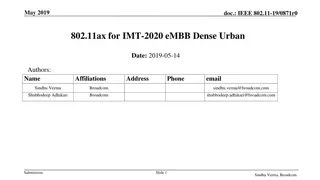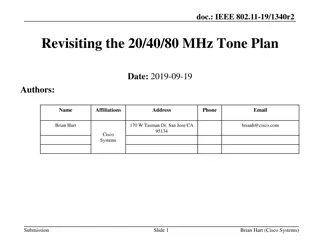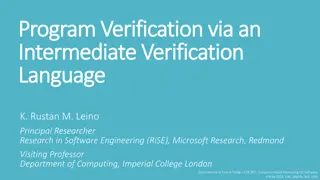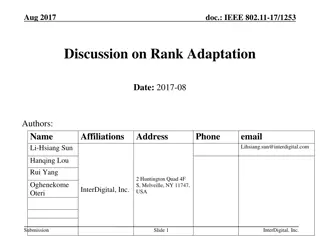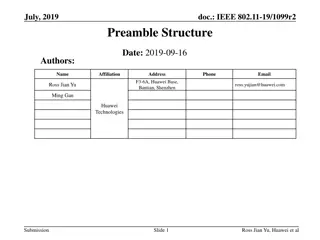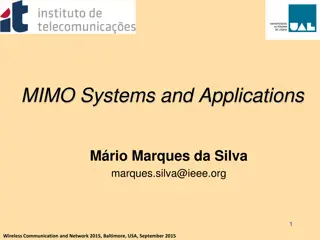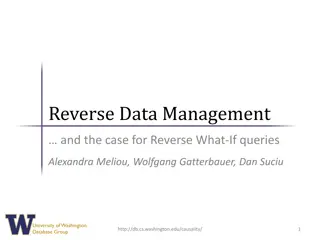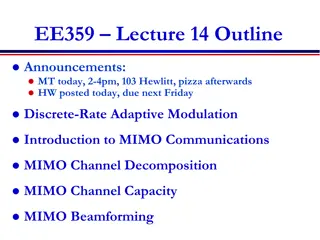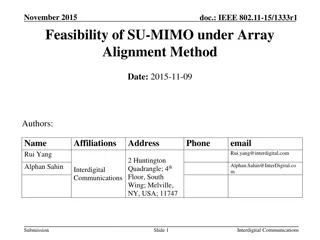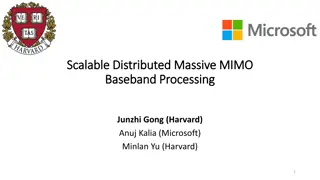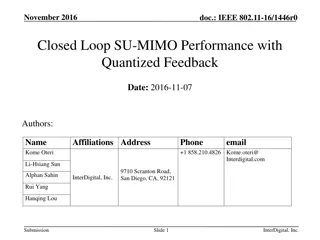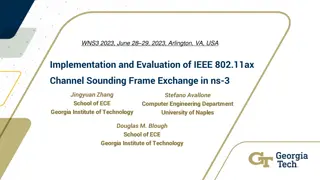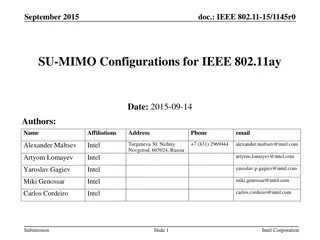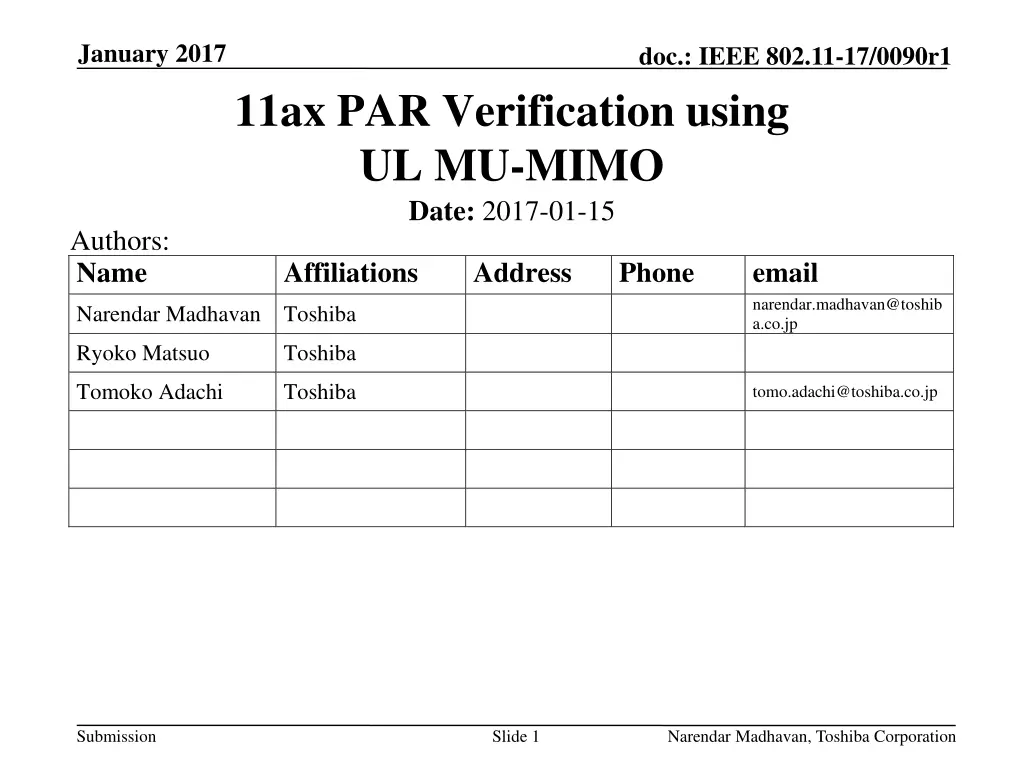
Understanding IEEE 802.11ax UL MU-MIMO for Throughput Gain Verification
Explore how UL MU-MIMO technology in IEEE 802.11ax promises significant throughput improvements over 11ac, detailing simulation assumptions, results comparison with Huawei, and insights on improvements in dense scenarios. Verify the four times throughput gain using UL MU-MIMO.
Download Presentation

Please find below an Image/Link to download the presentation.
The content on the website is provided AS IS for your information and personal use only. It may not be sold, licensed, or shared on other websites without obtaining consent from the author. If you encounter any issues during the download, it is possible that the publisher has removed the file from their server.
You are allowed to download the files provided on this website for personal or commercial use, subject to the condition that they are used lawfully. All files are the property of their respective owners.
The content on the website is provided AS IS for your information and personal use only. It may not be sold, licensed, or shared on other websites without obtaining consent from the author.
E N D
Presentation Transcript
January 2017 doc.: IEEE 802.11-17/0090r1 11ax PAR Verification using UL MU-MIMO Date: 2017-01-15 Authors: Name Affiliations Address Phone email narendar.madhavan@toshib a.co.jp Narendar Madhavan Toshiba Ryoko Matsuo Toshiba Tomoko Adachi Toshiba tomo.adachi@toshiba.co.jp Submission Slide 1 Narendar Madhavan, Toshiba Corporation
January 2017 doc.: IEEE 802.11-17/0090r1 Introduction PAR of 11ax promises Four times throughput gain over 11ac. Many companies have provided simulation results for 4 times throughput improvement in PAR[1-5], using some features in 802.11ax, specifically, OFDMA, MU-MIMO and spatial reuse. This presentation is to verify the four times throughput gain using UL MU-MIMO, similar to [5] Align the results with other companies for PAR verification Submission Slide 2 Narendar Madhavan, Toshiba Corporation
January 2017 doc.: IEEE 802.11-17/0090r1 Simulation Assumptions [5] Scenario: Indoor, single BSS Channel model: Channel-D Bandwidth: 20MHz @ 5GHz Antenna number: AP: 4 ; non-AP STA: 1 Transmit Power: AP: 20dBm ; non-AP STA: 15dBm Traffic model: full buffer, UL only Packet size: 1460 bytes Access protocol: 802.11ac: EDCA 802.11ax: Trigger + UL MU-MIMO + M-BA (EDCA disabled) STA position: random (uniform distribution) within a certain BSS range STA BSS Range STA STA STA AP STA STA STA STA Simulation variable: STA number; BSS Range; Submission Slide 3 Narendar Madhavan, Toshiba Corporation
January 2017 doc.: IEEE 802.11-17/0090r1 UL-MU-MIMO Results Comparison with Huawei s Results [5] Setting: BSS range = 10 m Number of STAs range from 5 to 500 Random scheduling Packet Aggregation (Max AMPDU 64) 300 250 System Throughput in Mbps 200 150 100 Conclusion: All the STAs close to AP Use high MCS to transmit 11ac: Aggregate as many packets and send when channel accessed 11ax: UL MU Padding overhead, Trigger frame +M- BA overhead 50 0 11ac 11ax 11ac 11ax TOSHIBA HUAWEI 5 STAs 15 STAs 50 STAs 100 STAs 200 STAs 500 STAs Submission Slide 4 Narendar Madhavan, Toshiba Corporation
January 2017 doc.: IEEE 802.11-17/0090r1 11ax = Improvement in Dense Scenarios? 11ax is envisaged to improve throughput in dense scenarios Density as a parameter needs to be used to verify this claim ??????? =?????? ?? ???? ?(??? ?????)2 100 (??? ????? ?? ?) Setting: BSS range = 10 m & 40 m Vary Density (randomly) by varying number of STAs and BSS range Random scheduling Packet Aggregation ON and OFF Plot the throughput improvement of 11ax over 11ac averaged over a few ranges of Density, for 2 different BSS ranges , 10m and 40m respectively. STA BSS Range STA STA STA AP STA STA STA STA Submission Slide 5 Narendar Madhavan, Toshiba Corporation
January 2017 doc.: IEEE 802.11-17/0090r1 11ax = Improvement in Dense Scenarios? Throughput improvement vs Density for UL MU MIMO 20 X times Throughput Improvement 15 10 5 0 1.591550775 4.774652326 15.91550775 31.8310155 63.66203101 159.1550775 212.20677 Number of STAs per 100 m^2 BSS Range =10m (Agg OFF) BSS Range = 10m (Agg ON) BSS Range = 40m (Agg OFF) BSS Range = 40m (Agg ON) Submission Slide 6 Narendar Madhavan, Toshiba Corporation
January 2017 doc.: IEEE 802.11-17/0090r1 Conclusion We demonstrate 4 times throughput gain using UL MU- MIMO AP deployments with high-density small cell size has the best performance of 11ax over 11ac The denser the STAs are deployed, more the gain of 11ax Heavy Collisions in 11ac causing channel access delays The throughput gain is more when the STAs are deployed closer to the AP Higher MCS and aggregation gain Future work: Focus on aligning the results for OFDMA with other companies Consider a more realistic traffic(DL/UL) and simulation scenario (multiple BSS) Submission Slide 7 Narendar Madhavan, Toshiba Corporation
January 2017 doc.: IEEE 802.11-17/0090r1 References [1] 11-15-1095-10-00ax-ofdma-performance-in-11ax [2] 11-16-1143-01-00ax-11ax-par-verification [3] 11-16-1198-03-00ax-preliminary-11ax-par-verification [4] 11-16-1166-00-00ax-meeting-par-requirements-with- ul-ofdma [5] 11-16-1414-00-00ax-Verifying PAR using UL MU MIMO Submission Slide 8 Narendar Madhavan, Toshiba Corporation
January 2017 doc.: IEEE 802.11-17/0090r1 Observations When Aggregation OFF, 11ac s performance is poor, owing to the channel access overhead by the STAs each time while 11ax ULMUMIMO has multiplexing gain, this reflects as improved throughput gain as compared to when Aggregation is ON. For high dense scenarios (high density), 11ac fails miserably with collisions, 11ax uses Trigger for UL, hence no collisions , therefore there is an increase in the throughput gain as density increase For BSS range =40m, 11ax and 11ac performance is lower than the case of 10m. In addition when the density increase, the gap increases as well Throughput gain can be more than 4 times Submission Slide 9 Narendar Madhavan, Toshiba Corporation




